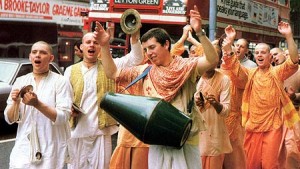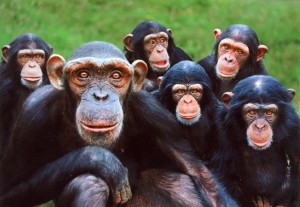“Cult” is a loaded word, one with many negative connotations and a few neutral ones. Consider the variable way the term is used: cult object, religious cult, fringe cult, cult of personality, cult movie, false cult—which appears to imply there is such a thing as a “true” cult. A formal definition is somewhat more polite: a cohesive social group devoted to beliefs or practices that the surrounding population considers to be outside the mainstream. The formal definition makes no effort to distinguish between benign and malign, harmful and beneficial, “normal” and pathological. But to many of us, the word conjures up images of wild-eyed, brainwashed zombies selling flowers at the airport, kowtowing to some conman with expensive tastes and delusions of grandeur.
Because the word has so much baggage, many sociologists of religion prefer to substitute the term NRM, or New Religious Movement, which is itself an interesting term. More or less incidentally, it makes the point that “cult” characteristics are not limited to the wild-eyed brainwashed delusional brigade, but are shared with more acceptable, culturally normative belief systems—that is to say, with religions. Indeed, some historians see the accepted religions as having their origins in fringe cults, which eventually moved from the fringe into the mainstream, a process called routinization. Which reminds me of that sad old joke: What is the difference between a cult and religion? Answer: About fifty years.
Even if one does not find that joke funny, it is arguable that important characteristics of mainstream religion and also of many political movements and, for that matter, business corporations and social organizations, reflect a strong affinity with those of cults. For example, there is the veneration for a charismatic leader: Jesus, Moses, Mao Zedong, the Reverend Sun Moon, Milton Friedman, Ayn Rand. Then there is the belief that the leader is the recipient of some great truth or mission, which has been written down as received scripture: the Bible, the Koran, the Book of Mormon, Mao’s Little Red Book, Atlas Shrugged, Mein Kampf, the Ruhnama. Third, there is the separation into an in-group and everybody else: the righteous versus the unrighteous, the capitalists versus the proletariat, the doomed versus those with a place in the lifeboat. But we are dealing primarily with messiahs and the organizations they found, not with their more respectable cousins—so the first order of business is to look at the personnel of messianic cults, on whatever scale.
The first ingredient, obviously, is a messianic leader. Messiahs are hugely various in style and narrative detail, as witness the examples in the previous installment, but they fall into a limited range of personality types. A common and necessary factor is charisma: personal magnetism, plausibility, and a disarming charm. Messiahs have a rock-star quality. Much is made of their penetrating eyes, eloquence, ability to command loyalty and even worship. You hear it again and again from the mouths of those who have been in contact with messianic personages: He made me feel so important. It was like she was speaking directly to me. He seemed to know what I was thinking. In short, messiahs are almost certain to be what students of animal behavior call “alpha males” or (less commonly) “alpha females”. The borrowed term is not inappropriate—there are parallels between how power and dominance operate within a human social group, and within social groups of our near relatives, the other great apes. Moreover, just as in other primate groups, a messiah does not usually achieve that exalted status all by him- or herself. Help is often required.
This brings up a second messianic quality: a knack for building up an elite inner circle of trusted aides and enforcers: top disciples, as it were, who act both as liaison and as insulation between a messiah and the eventual mass of lesser followers. Among these may be one that is a little more powerful than the others, a little closer to the messiah. “Messiah’s sidekick” is a job description that carries a lot of perks, but the position can also be uncomfortable, dangerous, and even fatal. As well, the messiah may have a consort, often engaged in an uneasy relationship with the rest of the inner circle.
A third messianic trait is one of those leadership qualities that is open to opposing spins, horrifying some observers while arousing the admiration of others. Tactfully put, it is a willingness to subordinate the welfare of the followers to the good of the organization—which, all too often, is identified with the good of the messiah. Less tactfully put, the leadership qualities of a messianic personality may have a distinct flavor of narcissism: self-absorption, delusions of omnipotence, grandiosity, and a burning need for attention and control. Also— though one cannot usually sit them down and give them personality tests—messianic characters may display the primary markers of a clinical psychopath, notably the lack of any capacity for empathy, for considering the needs or wants of other people. There are other significant markers of psychopathic behaviour that also commonly show up, and we shall consider these when they arise. In summary, for a classic messiah, however admirable or uplifting his stated aims, everything often boils down to the messianic ego and the desire for power and control.
A fourth point is not so much a characteristic of messiahs as a frequent motif in their narratives, frequent enough to suggest something significant is behind it. Time after time, some unremarkable Joe Blow falls sick with a fever, has some truly trippy dreams, and wakes up as literally a different man: charismatic, driven, uniquely chosen for some apocalyptic mission or other. These transformative fevers may coincide, actually or symbolically, with sojourns in the wilderness. Wovoka of the Ghost Dance, Hong Xiuquan of the Tai Ping, Mohammed in the cave, Jesus on the mountain, Hitler in Pasewalk, and many more–enough to hint, only slightly snarkily, that messiahship may be largely an unfortunate side effect of some forms of brain damage. This is also something we shall come back to in due course.
But take note: the personality quirks of a messiah do not necessarily mean he or she will have a totally malign influence, or inevitably blaze a path to disaster. There are a number of ways for messianic movements to play out, and some of those endings are successful, with the messiahs entering history as statesmen, as conquerors, as billionaire business moguls, as all-around exceptional human beings, or even as superhuman. This brings up an interesting and little-noticed point to do with the inner circle of disciples.
Messianic organizations have a much better chance of succeeding if they are led by, not one, but by two messiahs – that is, the charismatic leader who starts the ball rolling, plus a kind of secondary messiah, the Number One Fan who effectively functions as the messiah’s right hand, business manager, and heir apparent. When the glorious leader dies, fails, or is martyred, which is not an uncommon outcome, it is the sidekick who carries on with the movement in the name of the original messiah. Lenin and Stalin spring to mind; the Mahdi and his Khalifa in 19th century Sudan; Joseph Smith and Brigham Young; Jesus and the disciples James and Peter, plus their rival, the Apostle Paul; the late president-for-eternal-life of Korea, and his son, now also co-ruling from heaven. But the messiahs and their inner circles are only part of the equation.
You cannot have a leader without followers, any more than you can have a wedding without a groom. But what characterizes the followers? Are there common patterns? There are, as it happens; but initially one must look at what the followers are not. First, contrary to how some of their behavior might appear to outsiders, they are not stupid. Many tend to be intelligent and able, often middle class, reasonably affluent, and well-educated. Similarly, they are not crazy. From the outside, they might look delusional, especially when a really nutty cult or an extremist organization is involved—you have to be crazy, right, to pour cyanide down your baby’s throat, or strap bombs to your own body and go for a walk in a crowded market? But the people in question are largely sane by any clinical definition, and acting reasonably according to their “insider” standards. So how do they get pulled in?
Many of the techniques used to attract cult followers are familiar to us, because they are the same techniques used to sell us things or talk us into voting for a certain party. In general, we call this “advertising” if we approve of it, and “propaganda” if we do not. The manipulation of fears, hopes, greed, loneliness, altruism, beliefs and good intentions has been brought to a fine art in recent times in the service of commerce and politics, but the same toolkit of persuasion can be seen in one form or another, going a very long way back.
Then there are psychological techniques that are a little more pressing, associated in our eyes with brainwashing, destructive mind-control cults, and even with forms of torture: control of information, physical deprivation, isolation, deception, induced dependency, love-bombing, carrot-and-stick headgames, peer pressure, ego breakdown, and sensory overload. In many ways, however, these are just extreme forms of the same tricks used in advertising and propaganda. Anyone who has been through a time-share presentation will have experienced a mild version of many of the same tactics: a come-on to get you past the door and create a sense of obligation, followed by an array of well-tested pressure tactics. Some of these exploit human impulses that are probably hardwired, in particular an inborn sense of fairness and reciprocity .
Then there are situational factors to do with the individual. It is well known from cult studies that we are most impressionable and most readily drawn to follow when approached at a time of vulnerability, self-doubt, or dissatisfaction with our current lot. The same message delivered to the same person at a different point in his or her life may have no effect. It is no accident that large-scale messianic movements tend to rise in times of social stress, when many individuals are in exactly that vulnerable, impressionable state.
What about the flip side of the question? Let’s say a messianic character with a particularly wonderful message manages to sweep most of his hearers off their feet; there will still be a bunch of awkward customers who will not bite–who will insist that, whatever their peers seem to be seeing, the emperor has no clothes. These nonconvertible outsiders are also a crucial part of the cultic equation, as the exceptions that prove the rule, and as the messiah’s source of necessary demons. But why are some people vulnerable to messianic charm, and others resistant? That is also a question we will return to later in the series.
Next instalment: the structure of messianic cults, and how they typically play out.



